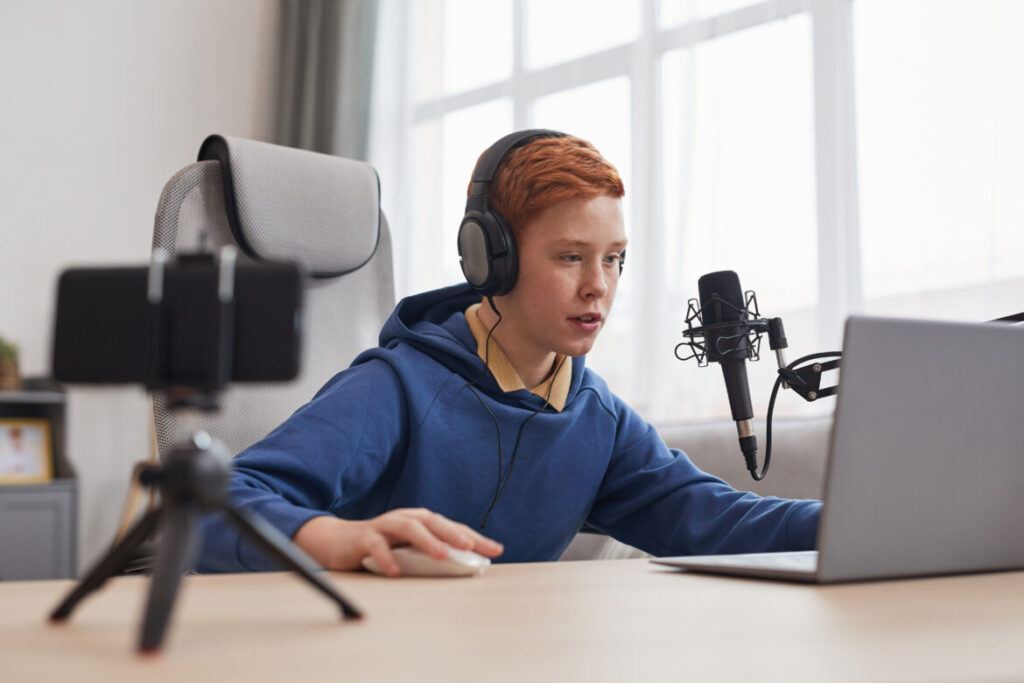In today’s digital age, podcasts have emerged as a dynamic platform for sharing ideas, building communities, and learning in innovative ways. For students, podcasting isn’t just a creative outlet; it’s a powerful tool to deepen understanding, develop essential skills, and connect with others. One of the most impactful Podcast Ideas for Students is creating a podcast to teach what you’re learning. This approach reinforces your knowledge and helps others by making complex topics accessible and engaging.

Why Teaching Through Podcasting Works
The idea of “learning by teaching” is rooted in cognitive science. When you explain a concept to someone else, you’re forced to organize your thoughts, simplify complex ideas, and present them in a way that makes sense. This process strengthens your grasp of the subject and highlights areas where you need further clarification.
By turning this into a podcast, you amplify the benefits. Podcasting allows you to:
- Reach a Wider Audience: Share your knowledge with classmates, students worldwide, or even professionals in your field.
- Develop Communication Skills: Improve your ability to articulate ideas clearly and confidently.
- Build a Portfolio: Create content that showcases your expertise and creativity, which can be a valuable addition to your resume or college application.
- Make Learning Fun: Transform studying into an interactive and enjoyable experience.
- Improve Time Management: Planning and publishing episodes teaches discipline and project management.
Many students often wonder, “What topics should I even talk about?” That’s where Podcast Ideas for Students come into play. Choosing the right theme can shape your podcast’s success, both academically and socially.
How to Get Started
If you’re excited about this idea, here’s a step-by-step guide to help you launch your educational podcast.
1. Choose a Topic You’re Passionate About
Start by selecting a subject you genuinely enjoy. It could be a course you’re taking, like math, history, or biology, or a skill you’re learning, such as coding, photography, or public speaking. Your enthusiasm will shine through and make your podcast more engaging and relatable.
Pro Tip: Try combining subjects. A student who loves literature and psychology could explore how authors portray mental health in their books. That’s a unique spin that could make your podcast stand out!
2. Break Down the Topic into Manageable Episodes
Avoid overwhelming your listeners. Divide your subject into smaller, focused topics. For example, if you’re creating a podcast about literature, each episode could explore a different book, author, or literary technique. This keeps your content organized and easier for your audience to digest.
Bonus Idea: You can plan themed weeks or monthly series. For example: “Science in Real Life – April Series,” where each episode covers how science applies to everyday activities.
3. Plan Your Episodes
Before recording, sketch out your episode outline. A solid structure includes:
- Introduction: Brief overview of the topic.
- Main Content: Key points, examples, and analysis.
- Conclusion: Recap and a teaser for the next episode.
Adding personal stories, real-world applications, or fun facts can help retain your audience’s interest.
Tools and Tips for a Great Podcast
You don’t need a studio setup. Here’s what you’ll need:
- Microphone: A USB microphone like the Blue Yeti or even your phone’s mic (with a quiet environment) can work well.
- Recording Software: Free tools like Audacity, GarageBand, or online platforms like Riverside.fm.
- Editing: Remove pauses, background noise, or filler words. You can also add intro music and transitions using royalty-free tracks from sites like Free Music Archive.
Want to stand out? Create a catchy podcast name and design an eye-catching cover art using Canva. It’s simple and free.
Sharing and Growing Your Podcast
After you record and edit, it’s time to share your creation with the world.
- Upload Platforms: Use free platforms like Spotify for Podcasters (formerly Anchor), Podbean, or Buzzsprout.
- Promotion: Share on social media, school groups, or even via email newsletters. You can also post short audio clips or quotes as teasers.
- Feedback Loop: Encourage listeners to leave comments or reviews. Use this input to improve your future episodes.
Podcast Ideas for Students can also evolve over time. Don’t be afraid to pivot your content based on listener interests or your own academic journey.
Real-Life Examples of Student Podcasts
Let’s look at how others have used Podcast Ideas for Students to inspire and educate:
- “The Exam Jam” by a group of high school seniors, tackled common academic challenges like study habits, procrastination, and test anxiety.
- “Code Chat” by a university computer science major featured mini-lessons on Python and JavaScript with real project demos.
- “Beyond the Bell” was a podcast by middle schoolers discussing social issues through the lens of their curriculum, from climate change to social justice.
These student-led podcasts not only helped their creators master subjects but also attracted thousands of young listeners globally.
Benefits of This Podcasting Approach
Creating a podcast to teach what you’re learning offers numerous advantages:
- Deeper Understanding: Teaching forces mastery.
- Skill Development: You’ll sharpen communication, research, and critical thinking skills.
- Confidence Building: Regularly speaking on topics improves self-assurance.
- Networking: Interviewing classmates, teachers, or professionals can lead to mentorship and collaboration opportunities.
- Leadership Potential: Hosting a podcast positions you as a thought leader among your peers.
- College & Career Edge: Admissions officers and employers love seeing creative, student-led projects.
Whether it’s for a school assignment or a personal project, Podcast Ideas for Students provides a perfect balance of creativity, education, and personal growth.
Tips for Creating an Engaging Educational Podcast

To truly make your podcast shine, consider the following tips:
- Keep It Concise: Ideal episode length is 20–30 minutes.
- Use Stories: Incorporate anecdotes, metaphors, or pop culture references.
- Invite Guests: A guest speaker brings new energy and perspectives.
- Interactive Format: Host Q&A sessions or listener polls.
- Consistency: Stick to a release schedule (weekly or bi-weekly) so your audience knows when to expect new content.
- Complement with Visuals: Share episode highlights on Instagram, Twitter, or a blog.
Advanced Podcast Ideas for Students
Want to take things further? Try these creative formats:
- Mini-Series: Create a 5-part podcast breaking down a semester’s worth of learning.
- Live Study Sessions: Record yourself reviewing before a test with tips and summaries.
- Cross-Curriculum Podcasts: Blend multiple subjects—like analyzing historical events through economics or literature.
- Language Learning: Practice vocabulary and grammar while teaching peers.
Using Podcast Ideas for Students this way ensures your podcast evolves as your learning does.
Final Thoughts
If you’re looking for a creative and impactful way to enhance your learning experience, consider embracing Podcast Ideas for Students. Creating a podcast to teach what you’re learning is not only a fun and rewarding project, but it’s also a powerful tool for personal and academic development. You’ll build confidence, strengthen communication skills, and gain a sense of purpose through teaching others.
So, grab a microphone, choose a topic that excites you, and start recording. Remember: every episode is a chance to solidify your knowledge and inspire someone else.
By investing your time in Podcast Ideas for Students, you’re not just keeping up with school work; you’re creating something meaningful, memorable, and possibly life-changing.


